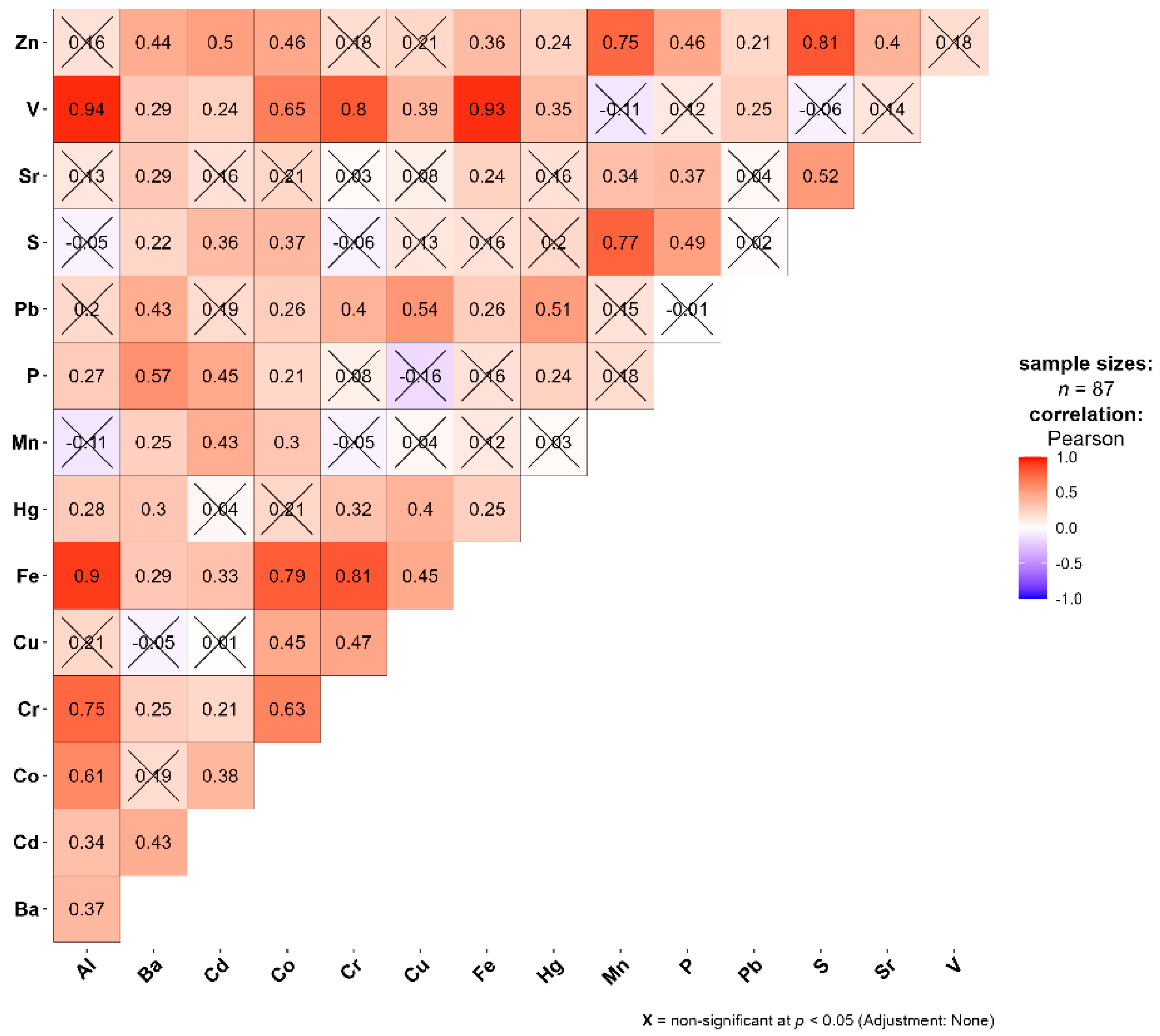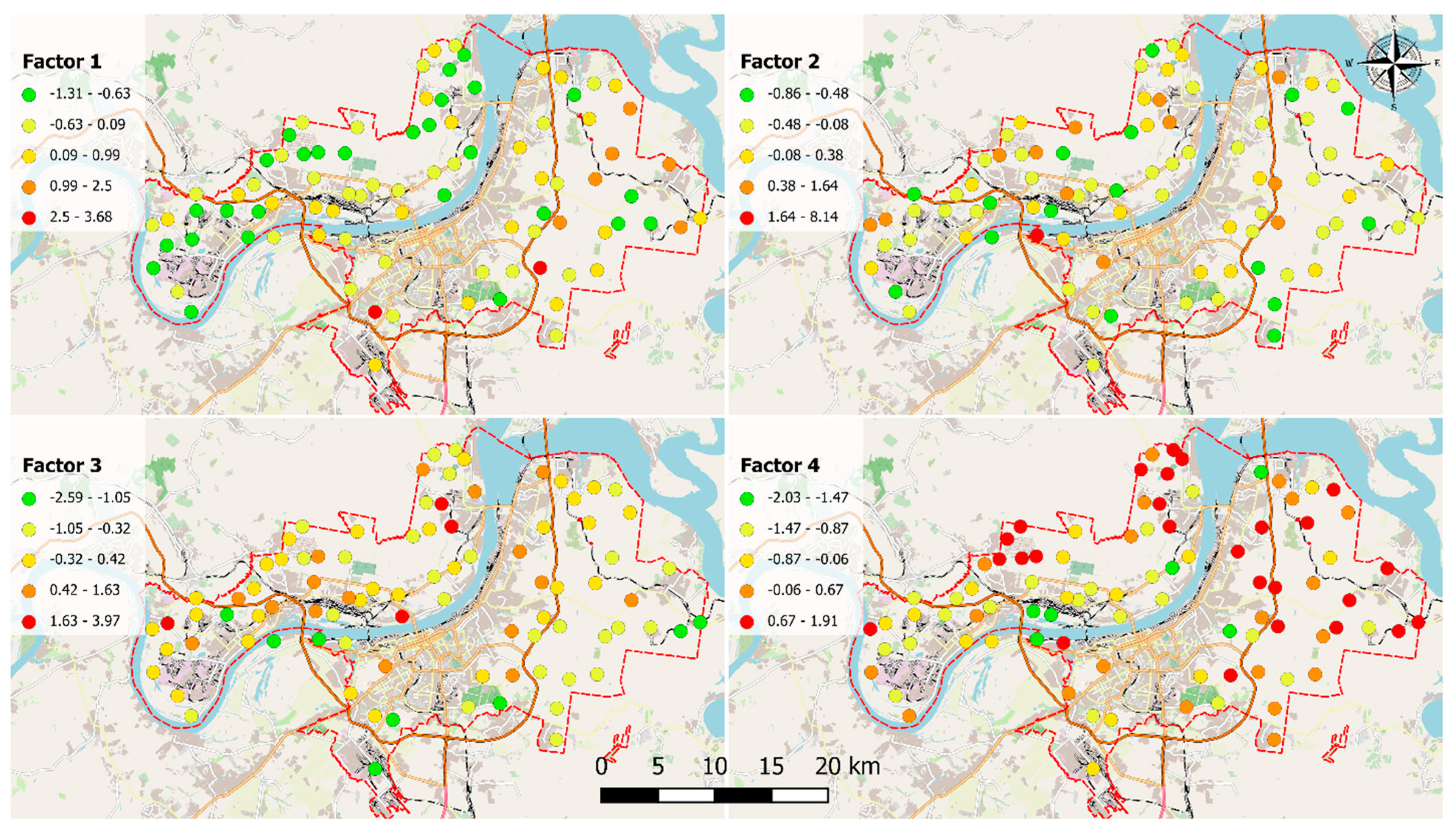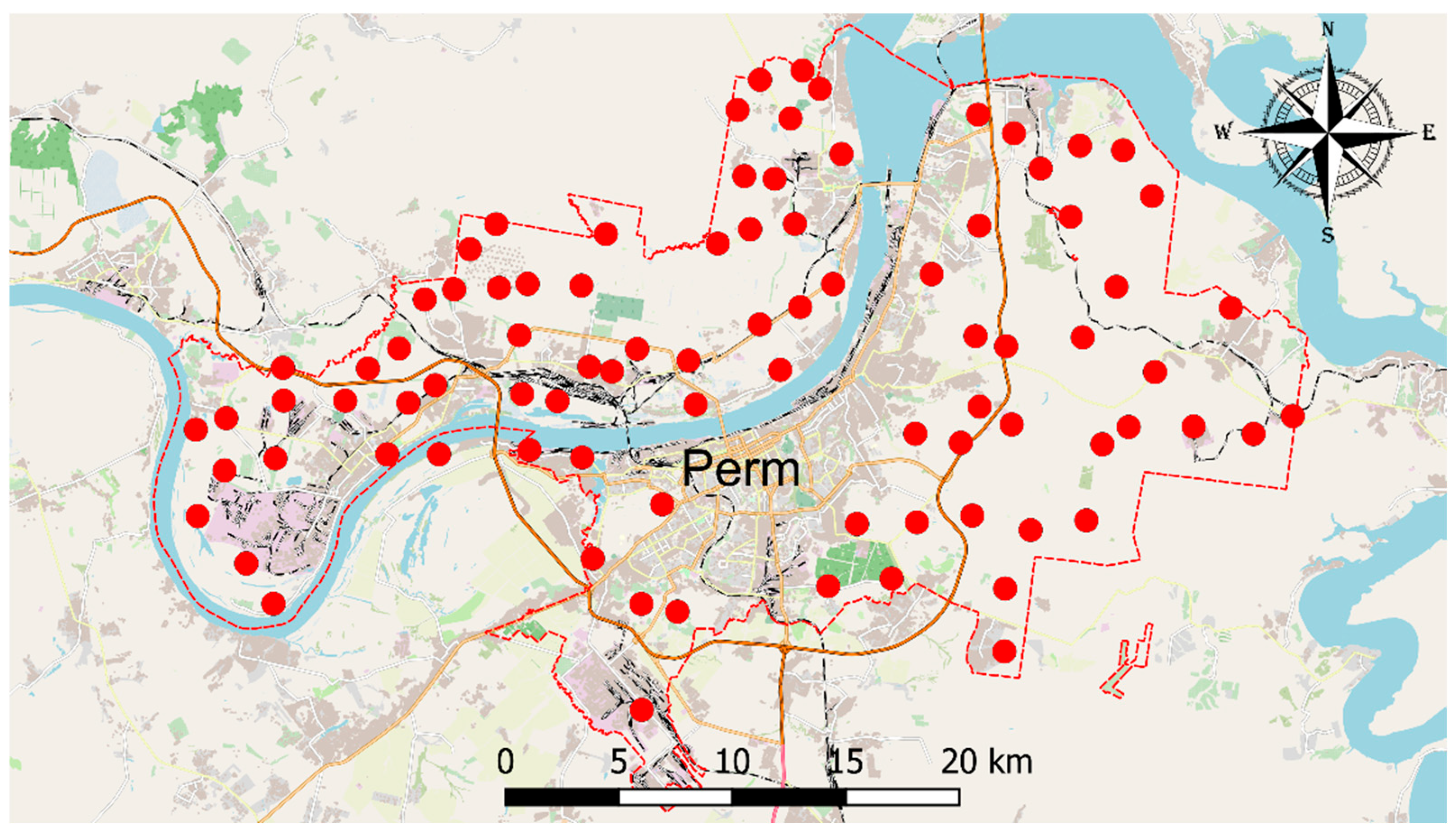Assessment of the Atmospheric Deposition of Potentially Toxic Elements Using Moss Pleurozium schreberi in an Urban Area: The Perm (Perm Region, Russia) Case Study
Abstract
1. Introduction
2. Results and Discussion
2.1. Basic Statistics
2.2. Correlation and Factor Analyses
2.3. Assessment of the Level of Air Pollution
3. Materials and Methods
3.1. Study Area
3.2. Sampling and Chemical Analysis
3.3. Statistical Analysis
3.4. Data Evaluation
4. Conclusions
Author Contributions
Funding
Data Availability Statement
Conflicts of Interest
References
- Bibi, D.; Tőzsér, D.; Sipos, B.; Molnár, V.É.; Simon, E.; Tóthmérész, B. Complex Study of Air Pollution Based on Tree Species in Vienna. Air Qual. Atmos. Health 2024, 17, 417–424. [Google Scholar] [CrossRef]
- WHO. Ambient (Outdoor) Air Pollution. Available online: https://www.who.int/news-room/fact-sheets/detail/ambient-(outdoor)-air-quality-and-health (accessed on 20 May 2024).
- Aksu, A. Sources of Metal Pollution in the Urban Atmosphere (A Case Study: Tuzla, Istanbul). J. Environ. Health Sci. Eng. 2015, 13, 79. [Google Scholar] [CrossRef] [PubMed]
- Adamiec, E.; Jarosz-Krzemińska, E.; Wieszała, R. Heavy Metals from Non-Exhaust Vehicle Emissions in Urban and Motorway Road Dusts. Environ. Monit. Assess. 2016, 188, 369. [Google Scholar] [CrossRef]
- Chen, L.C.; Maciejczyk, P.; Thurston, G.D. Metals and Air Pollution. In Handbook on the Toxicology of Metals: Volume I: General Considerations; Academic Press: Cambridge, MA, USA, 2021; pp. 137–182. ISBN 9780128232927. [Google Scholar]
- Cowden, P.; Aherne, J. Assessment of Atmospheric Metal Deposition by Moss Biomonitoring in a Region under the Influence of a Long Standing Active Aluminium Smelter. Atmos. Environ. 2019, 201, 84–91. [Google Scholar] [CrossRef]
- Mao, H.T.; Wang, X.M.; Wu, N.; Chen, L.X.; Yuan, M.; Hu, J.C.; Chen, Y.E. Temporal and Spatial Biomonitoring of Atmospheric Heavy Metal Pollution Using Moss Bags in Xichang. Ecotoxicol. Environ. Saf. 2022, 239, 113688. [Google Scholar] [CrossRef]
- Castell, N.; Dauge, F.R.; Schneider, P.; Vogt, M.; Lerner, U.; Fishbain, B.; Broday, D.; Bartonova, A. Can Commercial Low-Cost Sensor Platforms Contribute to Air Quality Monitoring and Exposure Estimates? Environ. Int. 2017, 99, 293–302. [Google Scholar] [CrossRef]
- Monaci, F.; Ancora, S.; Paoli, L.; Loppi, S.; Franzaring, J. Air Quality in Post-Mining Towns: Tracking Potentially Toxic Elements Using Tree Leaves. Environ. Geochem. Health 2023, 45, 843–859. [Google Scholar] [CrossRef] [PubMed]
- Ștefănuț, S.; Öllerer, K.; Ion, M.C.; Florescu, L.I.; Constantin, M.; Banciu, C.; Onete, M.; Manu, M.; Vicol, I.; Moldoveanu, M.M.; et al. Country-Scale Complementary Passive and Active Biomonitoring of Airborne Trace Elements for Environmental Risk Assessment. Ecol. Indic. 2021, 126, 107357. [Google Scholar] [CrossRef]
- Solgi, E.; Keramaty, M.; Solgi, M. Biomonitoring of Airborne Cu, Pb, and Zn in an Urban Area Employing a Broad Leaved and a Conifer Tree Species. J. Geochem. Explor. 2020, 208, 106400. [Google Scholar] [CrossRef]
- Urošević, M.A.; Lazo, P.; Stafilov, T.; Nečemer, M.; Andonovska, K.B.; Balabanova, B.; Hristozova, G.; Papagiannis, S.; Stihi, C.; Suljkanović, M.; et al. Active Biomonitoring of Potentially Toxic Elements in Urban Air by Two Distinct Moss Species and Two Analytical Techniques: A Pan-Southeastern European Study. Air Qual. Atmos. Health 2023, 16, 595–612. [Google Scholar] [CrossRef]
- Chaudhuri, S.; Roy, M. Global Ambient Air Quality Monitoring: Can Mosses Help? A Systematic Meta-Analysis of Literature about Passive Moss Biomonitoring. Environ. Dev. Sustain. 2024, 26, 5735–5773. [Google Scholar] [CrossRef]
- Frontasyeva, M.; Harmens, H.; Uzhinskiy, A.; Chaligava, O. Mosses as Biomonitors of Air Pollution: 2015/2016 Survey on Heavy Metals, Nitrogen and POPs in Europe and Beyond; Report of the ICP Vegetation Moss Survey Coordination Centre; LRTAP: Châtelaine, Switzerland, 2020; ISBN 9785953005081. [Google Scholar]
- Boquete, M.T.; Lang, I.; Weidinger, M.; Richards, C.L.; Alonso, C. Patterns and Mechanisms of Heavy Metal Accumulation and Tolerance in Two Terrestrial Moss Species with Contrasting Habitat Specialization. Environ. Exp. Bot. 2021, 182, 104336. [Google Scholar] [CrossRef]
- Kılıç, Ö.; Belivermiş, M.; Sıkdokur, E.; Sezer, N.; Erentürk, S.A.; Haciyakupoglu, S.; Chaligava, O.; Frontasyeva, M.; Zinicovscaia, I.; Madadzada, A. Temporal Changes of Atmospheric Deposition of Major and Trace Elements in European Turkey, Thrace Region. J. Radioanal. Nucl. Chem. 2021, 329, 371–381. [Google Scholar] [CrossRef]
- Maresca, V.; Bellini, E.; Landi, S.; Capasso, G.; Cianciullo, P.; Carraturo, F.; Pirintsos, S.; Sorbo, S.; Sanità di Toppi, L.; Esposito, S.; et al. Biological Responses to Heavy Metal Stress in the Moss Leptodictyum riparium (Hedw.) Warnst. Ecotoxicol. Environ. Saf. 2022, 229, 113078. [Google Scholar] [CrossRef] [PubMed]
- Wolterbeek, B. Biomonitoring of Trace Element Air Pollution: Principles, Possibilities and Perspectives. Environ. Pollut. 2002, 120, 11–21. [Google Scholar] [CrossRef]
- Ares, A.; Aboal, J.R.; Carballeira, A.; Giordano, S.; Adamo, P.; Fernández, J.A. Moss Bag Biomonitoring: A Methodological Review. Sci. Total Environ. 2012, 432, 143–158. [Google Scholar] [CrossRef] [PubMed]
- Harmens, H.; Norris, D.A.; Steinnes, E.; Kubin, E.; Piispanen, J.; Alber, R.; Aleksiayenak, Y.; Blum, O.; Coşkun, M.; Dam, M.; et al. Mosses as Biomonitors of Atmospheric Heavy Metal Deposition: Spatial Patterns and Temporal Trends in Europe. Environ. Pollut. 2010, 158, 3144–3156. [Google Scholar] [CrossRef] [PubMed]
- Capozzi, F.; Giordano, S.; Di Palma, A.; Spagnuolo, V.; De Nicola, F.; Adamo, P. Biomonitoring of Atmospheric Pollution by Moss Bags: Discriminating Urban-Rural Structure in a Fragmented Landscape. Chemosphere 2016, 149, 211–218. [Google Scholar] [CrossRef]
- Świsłowski, P.; Vergel, K.; Zinicovscaia, I.; Rajfur, M.; Wacławek, M. Mosses as a Biomonitor to Identify Elements Released into the Air as a Result of Car Workshop Activities. Ecol. Indic. 2022, 138, 108849. [Google Scholar] [CrossRef]
- Zinicovscaia, I.; Narmandakh, J.; Yushin, N.; Peshkova, A.; Chaligava, O.; Tsendsuren, T.O.; Tserendorj, B.; Tsogbadrakh, T. Assessment of Air Pollution in Ulaanbaatar Using the Moss Bag Technique. Arch. Environ. Contam. Toxicol. 2024, 86, 152–164. [Google Scholar] [CrossRef]
- Chapin, F.S.; Oechel, W.C.; Van Cleve, K.; Lawrence, W. The Role of Mosses in the Phosphorus Cycling of an Alaskan Black Spruce Forest. Oecologia 1987, 74, 310–315. [Google Scholar] [CrossRef] [PubMed]
- Liu, X.; Wang, Z.; Li, X.; Bao, W. Nitrogen and Phosphorus Translocation of Forest Floor Mosses as Affected by a Pulse of These Nutrients. J. Plant Ecol. 2020, 13, 633–640. [Google Scholar] [CrossRef]
- Vergel, K.; Zinicovscaia, I.; Yushin, N.; Chaligava, O.; Nekhoroshkov, P.; Grozdov, D. Moss Biomonitoring of Atmospheric Pollution with Trace Elements in the Moscow Region, Russia. Toxics 2022, 10, 66. [Google Scholar] [CrossRef] [PubMed]
- Lazo, P.; Kika, A.; Qarri, F.; Bekteshi, L.; Allajbeu, S.; Stafilov, T. Air Quality Assessment by Moss Biomonitoring and Trace Metals Atmospheric Deposition. Aerosol Air Qual. Res. 2022, 22, 220008. [Google Scholar] [CrossRef]
- Charron, A.; Polo-Rehn, L.; Besombes, J.L.; Golly, B.; Buisson, C.; Chanut, H.; Marchand, N.; Guillaud, G.; Jaffrezo, J.L. Identification and Quantification of Particulate Tracers of Exhaust and Non-Exhaust Vehicle Emissions. Atmos. Chem. Phys. 2019, 19, 5187–5207. [Google Scholar] [CrossRef]
- Faiz, Y.; Siddique, N.; Tufail, M. Pollution Level and Health Risk Assessment of Road Dust from an Expressway. J. Environ. Sci. Health—Part A Toxic/Hazard. Subst. Environ. Eng. 2012, 47, 818–829. [Google Scholar] [CrossRef]
- Murakami, M.; Nakajima, F.; Furumai, H.; Tomiyasu, B.; Owari, M. Identification of Particles Containing Chromium and Lead in Road Dust and Soakaway Sediment by Electron Probe Microanalyser. Chemosphere 2007, 67, 2000–2010. [Google Scholar] [CrossRef]
- Shafer, M.M.; Toner, B.M.; Overdier, J.T.; Schauer, J.J.; Fakra, S.C.; Hu, S.; Herner, J.D.; Ayala, A. Chemical Speciation of Vanadium in Particulate Matter Emitted from Diesel Vehicles and Urban Atmospheric Aerosols. Environ. Sci. Technol. 2012, 46, 189–195. [Google Scholar] [CrossRef]
- Wiłkomirski, B.; Sudnik-Wójcikowska, B.; Galera, H.; Wierzbicka, M.; Malawska, M. Railway Transportation as a Serious Source of Organic and Inorganic Pollution. Water Air Soil Pollut. 2011, 218, 333–345. [Google Scholar] [CrossRef]
- Mehra, S.; Singh, M.; Sharma, G.; Kumar, S.; Navishi; Chadha, P. Impact of Construction Material on Environment. In Ecological and Health Effects of Building Materials; Springer International Publishing: Berlin/Heidelberg, Germany, 2021; pp. 427–442. ISBN 9783030760731. [Google Scholar]
- Sun, Y.; Han, Z.; Du, Z.; Li, Z.; Cong, X. Preparation and Performance of Environmental Friendly Sulphur-Free Propellant for Fireworks. Appl. Therm. Eng. 2017, 126, 987–996. [Google Scholar] [CrossRef]
- Jones, F.; Bankiewicz, D.; Hupa, M. Occurrence and Sources of Zinc in Fuels. Fuel 2014, 117, 763–775. [Google Scholar] [CrossRef]
- Röllin, H.B.; Nogueira, C.M.C.A. Manganese: Environmental Pollution and Health Effects. In Encyclopedia of Environmental Health; Elsevier: Amsterdam, The Netherlands, 2011; Volume 3, pp. 617–629. ISBN 9780444522733. [Google Scholar]
- Wu, R.; Yao, F.; Li, X.; Shi, C.; Zang, X.; Shu, X.; Liu, H.; Zhang, W. Manganese Pollution and Its Remediation: A Review of Biological Removal and Promising Combination Strategies. Microorganisms 2022, 10, 2411. [Google Scholar] [CrossRef] [PubMed]
- Loranger, S.; Zayed, J. Manganese and Lead Concentrations in Ambient Air and Emission Rates from Unleaded and Leaded Gasoline between 1981 and 1992 in Canada: A Comparative Study. Atmos. Environ. 1994, 28, 1645–1651. [Google Scholar] [CrossRef]
- Rehman, M.; Liu, L.; Wang, Q.; Saleem, M.H.; Bashir, S.; Ullah, S.; Peng, D. Copper Environmental Toxicology, Recent Advances, and Future Outlook: A Review. Environ. Sci. Pollut. Res. 2019, 26, 18003–18016. [Google Scholar] [CrossRef]
- Yang, J.; Li, X.; Xiong, Z.; Wang, M.; Liu, Q. Environmental Pollution Effect Analysis of Lead Compounds in China Based on Life Cycle. Int. J. Environ. Res. Public Health 2020, 17, 2184. [Google Scholar] [CrossRef]
- Zhang, R.; Wilson, V.L.; Hou, A.; Meng, G. Source of Lead Pollution, Its Influence on Public. Int. J. Health Anim. Sci. Food Saf. 2015, 2, 18–31. [Google Scholar]
- OECD. Risk Reduction Monograph No. 4: Mercury_Background and National Experience with Reducing Risk; OECD Environment monograph series no. 103; OECD: Paris, France, 1995. [Google Scholar]
- Pavithra, K.G.; SundarRajan, P.; Kumar, P.S.; Rangasamy, G. Mercury Sources, Contaminations, Mercury Cycle, Detection and Treatment Techniques: A Review. Chemosphere 2023, 312, 137314. [Google Scholar] [CrossRef]
- Meng, Y.; Li, R.; Fu, H.; Bing, H.; Huang, K.; Wu, Y. The Sources and Atmospheric Pathway of Phosphorus to a High Alpine Forest in Eastern Tibetan Plateau, China. J. Geophys. Res. Atmos. 2020, 125, e2019JD031327. [Google Scholar] [CrossRef]
- Meshchurova, Т.А. Assessment of air pollution in the cities of Perm region. Bull. Nizhnevartovsk State Univ. 2020, 1, 110–119. [Google Scholar] [CrossRef]
- Leading Large and Medium Enterprises (Organizations) of the City of Perm. Available online: http://invest.gorodperm.ru/o-gorode/industrial/predpriytiy goroda/ (accessed on 29 May 2024).
- Perm Enterprises, Perm Plants, Industry. Available online: https://ibprom.ru/predpriyatiya-permi (accessed on 29 May 2024).
- Pederson, E.R.A.; Warshan, D.; Rasmussen, U. Genome Sequencing of Pleurozium schreberi: The Assembled and Annotated Draft Genome of a Pleurocarpous Feather Moss. G3 Genes Genomes Genet. 2019, 9, 2791–2797. [Google Scholar] [CrossRef]
- Zinicovscaia, I.; Chaligava, O.; Yushin, N.; Grozdov, D.; Vergel, K.; Hramco, C. Moss Biomonitoring of Atmospheric Trace Element Pollution in the Republic of Moldova. Arch. Environ. Contam. Toxicol. 2022, 82, 355–366. [Google Scholar] [CrossRef] [PubMed]
- Fernández, J.A.; Carballeira, A. Evaluation of Contamination, by Different Elements, in Terrestrial Mosses. Arch. Environ. Contam. Toxicol. 2001, 40, 461–468. [Google Scholar] [CrossRef] [PubMed]
- Tomlinson, D.L.; Wilson, J.G.; Harris, C.R.; Jeffrey, D.W. Problems in the Assessment of Heavy-Metal Levels in Estuaries and the Formation of a Pollution Index. Helgol. Meeresunters. 1980, 33, 566–575. [Google Scholar] [CrossRef]
- Wu, W.; Wu, P.; Yang, F.; Sun, D.L.; Zhang, D.X.; Zhou, Y.K. Assessment of Heavy Metal Pollution and Human Health Risks in Urban Soils around an Electronics Manufacturing Facility. Sci. Total Environ. 2018, 630, 53–61. [Google Scholar] [CrossRef]
- Hakanson, L. An Ecological Risk Index for Aquatic Pollution Control.a Sedimentological Approach. Water Res. 1980, 14, 975–1001. [Google Scholar] [CrossRef]



| Element | Min | Max | Mean | Median | SD | CV % | Background |
|---|---|---|---|---|---|---|---|
| Al | 564 | 9038 | 2322 | 1803 | 1743 | 75 | 815.0 |
| Ba | 19.7 | 169.1 | 70.2 | 72.8 | 34.3 | 49 | 32.3 |
| Cd | 0.12 | 0.55 | 0.24 | 0.22 | 0.09 | 36 | 0.16 |
| Co | 0.34 | 3.75 | 1.28 | 1.12 | 0.68 | 53 | 0.25 |
| Cr | 2.1 | 15.6 | 5.6 | 5.3 | 2.6 | 47 | 1.43 |
| Cu | 6.6 | 22.6 | 11.4 | 10.9 | 3.1 | 27 | 5.18 |
| Fe | 490 | 6088 | 1975 | 1685 | 1196 | 61 | 410 |
| Mn | 51 | 3137 | 434 | 350 | 359 | 83 | 164 |
| P | 1405 | 4042 | 2700 | 2752 | 574 | 21 | 2455 |
| Pb | 2.7 | 14.7 | 5.8 | 5.7 | 1.9 | 34 | 3.35 |
| S | 1009 | 4641 | 1654 | 1601 | 415 | 25 | 1216 |
| Sr | 19.4 | 87.5 | 35.8 | 32.8 | 12.8 | 36 | 26.22 |
| V | 2.1 | 24.3 | 7.3 | 6.2 | 4.7 | 65 | 1.77 |
| Zn | 34.7 | 201.8 | 65.2 | 60.2 | 22.5 | 35 | 40.2 |
| Hg | 0.018 | 0.096 | 0.041 | 0.039 | 0.012 | 30 | 0.07 |
| Element | Factor 1 | Factor 2 | Factor 3 | Factor 4 |
|---|---|---|---|---|
| Al | 0.91 | −0.08 | 0.05 | 0.31 |
| Ba | 0.16 | 0.18 | 0.33 | 0.79 |
| Cd | 0.29 | 0.45 | −0.04 | 0.45 |
| Co | 0.77 | 0.43 | 0.11 | −0.07 |
| Cr | 0.84 | −0.04 | 0.31 | 0.02 |
| Cu | 0.38 | 0.18 | 0.65 | −0.44 |
| Fe | 0.95 | 0.19 | 0.12 | 0.06 |
| Hg | 0.15 | 0.05 | 0.76 | 0.22 |
| Mn | −0.07 | 0.89 | 0.05 | 0.02 |
| P | 0.08 | 0.34 | −0.03 | 0.79 |
| Pb | 0.15 | 0.05 | 0.87 | 0.07 |
| S | −0.04 | 0.93 | 0.04 | 0.12 |
| Sr | 0.09 | 0.52 | 0.04 | 0.26 |
| V | 0.94 | −0.07 | 0.17 | 0.13 |
| Zn | 0.17 | 0.86 | 0.16 | 0.23 |
| Prp. Total | 0.29 | 0.22 | 0.14 | 0.13 |
| Element | CF | PER | ||||
|---|---|---|---|---|---|---|
| Min | Max | Median | Min | Max | Median | |
| Al | 0.69 | 11.1 | 2.9 | |||
| Ba | 0.61 | 5.2 | 2.2 | |||
| Cd | 0.75 | 3.4 | 1.5 | 3.6 | 16.4 | 7.3 |
| Co | 1.4 | 15.0 | 5.1 | |||
| Cr | 1.4 | 10.9 | 3.9 | 4.1 | 31.1 | 11.2 |
| Cu | 1.3 | 4.4 | 2.2 | 33 | 113 | 57 |
| Fe | 1.2 | 14.8 | 4.8 | |||
| Mn | 0.31 | 19.1 | 2.6 | |||
| P | 0.57 | 1.6 | 1.1 | |||
| Pb | 0.81 | 4.4 | 1.7 | 13.6 | 73.6 | 29.0 |
| S | 0.83 | 3.8 | 1.4 | |||
| Sr | 0.74 | 3.3 | 1.4 | |||
| V | 1.2 | 13.7 | 4.1 | |||
| Zn | 0.86 | 5.0 | 1.6 | 34.7 | 201.8 | 65.2 |
| Hg | 0.26 | 1.4 | 0.6 | |||
| PLI | 1.05 | 3.3 | 2.0 | |||
| Determined Content, mg/kg | SD | Certified Value, mg/kg | Recovery, % | |
|---|---|---|---|---|
| Al | 213 | 1.6 | 252 | 85 |
| Ba | 46 | 0.2 | 41.6 | 111 |
| Cd | 2.41 | 0.017 | 2.23 | 108 |
| Co | 0.15 | 0.015 | 0.15 | 100 |
| Cr | 0.77 | 0.007 | 0.91 | 85 |
| Cu | 5.2 | 0.05 | 5.12 | 102 |
| Fe | 267 | 5.9 | 258 | 103 |
| Mn | 144 | 1.75 | 136 | 106 |
| Ni | 1.33 | 0.02 | 1.49 | 89 |
| P | 2798 | 21 | 2420 | 116 |
| Pb | 0.84 | 0.04 | 0.97 | 87 |
| S | 3886 | 88 | 3780 | 103 |
| Sr | 132 | 1.2 | 133 | 99 |
| V | 0.35 | 0.01 | 0.40 | 88 |
| Zn | 47.47 | 0.40 | 43.6 | 109 |
Disclaimer/Publisher’s Note: The statements, opinions and data contained in all publications are solely those of the individual author(s) and contributor(s) and not of MDPI and/or the editor(s). MDPI and/or the editor(s) disclaim responsibility for any injury to people or property resulting from any ideas, methods, instructions or products referred to in the content. |
© 2024 by the authors. Licensee MDPI, Basel, Switzerland. This article is an open access article distributed under the terms and conditions of the Creative Commons Attribution (CC BY) license (https://creativecommons.org/licenses/by/4.0/).
Share and Cite
Gatina, E.; Zinicovscaia, I.; Yushin, N.; Chaligava, O.; Frontasyeva, M.; Sharipova, A. Assessment of the Atmospheric Deposition of Potentially Toxic Elements Using Moss Pleurozium schreberi in an Urban Area: The Perm (Perm Region, Russia) Case Study. Plants 2024, 13, 2353. https://doi.org/10.3390/plants13172353
Gatina E, Zinicovscaia I, Yushin N, Chaligava O, Frontasyeva M, Sharipova A. Assessment of the Atmospheric Deposition of Potentially Toxic Elements Using Moss Pleurozium schreberi in an Urban Area: The Perm (Perm Region, Russia) Case Study. Plants. 2024; 13(17):2353. https://doi.org/10.3390/plants13172353
Chicago/Turabian StyleGatina, Evgeniya, Inga Zinicovscaia, Nikita Yushin, Omari Chaligava, Marina Frontasyeva, and Alina Sharipova. 2024. "Assessment of the Atmospheric Deposition of Potentially Toxic Elements Using Moss Pleurozium schreberi in an Urban Area: The Perm (Perm Region, Russia) Case Study" Plants 13, no. 17: 2353. https://doi.org/10.3390/plants13172353
APA StyleGatina, E., Zinicovscaia, I., Yushin, N., Chaligava, O., Frontasyeva, M., & Sharipova, A. (2024). Assessment of the Atmospheric Deposition of Potentially Toxic Elements Using Moss Pleurozium schreberi in an Urban Area: The Perm (Perm Region, Russia) Case Study. Plants, 13(17), 2353. https://doi.org/10.3390/plants13172353








